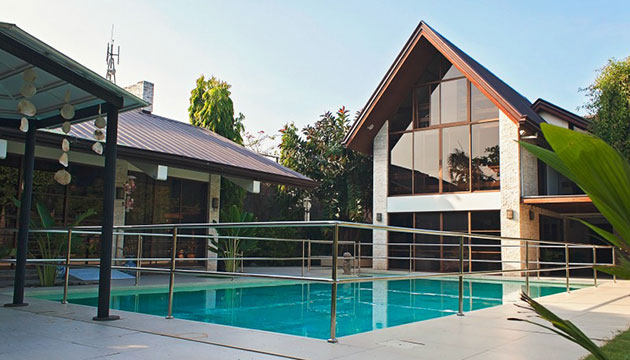Growing old is tough. If one is sick, it is even tougher not only for the ill and ageing senior but for the supporting family as well. But respect and care for the elderly is paramount in Philippine culture and a nursing home is not always the solution. Elders are considered key members of the family, a source of wisdom and Filipino values that must be passed on to the next generation.
Thus putting an ailing parent or grandparent in a nursing home is alien to most Filipinos. But there are circumstances when a family has no other choice.
It pains me to discuss this topic of caring for a sick and ageing family member because it evokes many sad and unpleasant memories about my late husband. Several years ago, he had an accident that deprived his brain of oxygen for some time. It resulted in a kind of brain injury which the neurologists finally diagnosed as akin to Alzheimer’s disease. In the beginning, his condition was manageable as he was responding well to medication. However, his condition worsened and it became difficult for all the family to cope with his erratic behavior.
Probably because my husband was beginning to lose his memory, he became irritable and uncontrollable. Several times in the middle of the night he would leave the house with all the doors wide open endangering the safety of the whole family. Early in the morning we would get a telephone call from a neighbor who knew him because he was well known in the village having been a former president of our neighborhood association, informing us that my husband had slept during the night in their garden. This went on for several nights which made the family decide, upon the recommendation of a neurologist, to look for a hospice that could better take care of him and keep him and his family safe.
A neurologist recommended the St.Camillus Medhaven in Marikina City, Metro Manila, operated by the Order of St. Camillus, a devout group of Roman Catholic men dedicated to the caring of male and female seniors with Alzheimer’s disease. The Medhaven is a non-profit organization that employs well-trained and highly skilled professionals who are competent and compassionate. Because it is a non-profit venture the fees for board and lodging are very reasonable and affordable. It provides resident-oriented, long-term full-time care, rehabilitative therapies, and adult daycare services. It has a dining hall, multipurpose hall, physical therapy building, large parking lot, security (with close circuit TV that monitors the surroundings 24/7 and guards), etc.
Later as my husband’s condition deteriorated it became necessary for us to hire the extra services of a 24-hour caregiver provided by the hospice for a fee, to take care of his personal needs as he was no longer independent. The caregiver assigned to him was a very competent and truly a kind and caring young man.
After about a year at the hospice, my husband became seriously ill. One day I received a call from the director informing me that my husband was taken to the hospital. But before I could even leave the house, he called again to tell me that my husband had died of organ failure.
In retrospect, I rationalized that his death was perhaps the better option for the ending of his life despite how painful it was for us who were left behind. This is because the Alzheimer’s disease reduces a person to “nothingness” – not remembering memories whether joyful or sad, nor recognizing family members and friends, and being totally dependent on another human being to take care of his personal needs. But of course, this is from the viewpoint of family members who are still in control of their faculties. It is difficult to speculate about the views of the person himself suffering from the disease. While a patient may have lost the memory of the past, what about his concerns about the present and the future? In the end we just have to pray to the Lord to help us to better understand and accept this painful event.
Growing Popularity of Nursing Homes in the Philippines
Because of the nature of Filipino families who are usually closely knit and caring, as mentioned earlier, the concept of nursing homes is not very popular in the Philippines. Grandmothers and grandfathers are considered standard members of the Filipino extended family. However, as in our case, sending an elderly family member to a nursing home became almost a necessity since he had acquired an unmanageable illness like Alzheimer’s.
That is why because of such undesirable and uncontrollable conditions, there are now several nursing homes in the Philippines operated as profit organizations. A nursing home in the Philippines is also referred to as skilled nursing facility, old people's homes, care homes, rest homes, convalescent homes or convalescent care. It is a facility for the residential care of elderly or disabled people, needing long-term care assistance. It is necessary for people who do not need to be in a hospital, but cannot be cared for at home. The nursing home nurses look after the patients' medical needs but doctors are on call for emergencies. Most nursing homes have nursing aides and skilled nurses on hand 24 hours a day. There are now nursing homes in all the major regions of Luzon, Visayas and Mindanao.
Comparing Philippine and Canadian Long Term Care Costs
One such facility, I am familiar with because I have a friend whose mother is a resident there is the “Bahay Dona Rosario.” It is located in a peaceful community in Muntinlupa, Metro Manila and operated by the Braintree Care Services & Senior Residences. The facility offers quality care based on the latest German standards combined with Filipino values and compassion. The services it provides are tailor-fitted to its resident's needs and wants that include minimum to maximum assistance, companionship, and 24/7 skilled nursing services. The staff is continuously trained by German Geriatric Care experts. All employees are Basic Life Support certified to be able to assist in cases of emergency. This residential care facility is based on European standards but maintains the flair of a Filipino family home.
There are two types of rates in this nursing home: semi-private and private. The semi-private rate (shared room and bath) is PhPesos 65, 000 while the private is PhPesos 75,000 per month (approximately CDN $1,625 and CDN$1,875 at the exchange rate of about PhPesos 40 to one Canadian dollar) or less than CDN $2,000 per month.
The rates, as defined by various Care Plans, include social activities, care bed, cabinet, bathroom, a 42” flat screen TV, Wi-Fi access, 24/7 air-conditioning, and 3 meals plus 2 snacks a day. Many Canadian Filipinos with dual citizenship who have decided to retire in the Philippines find this very reasonable compared to what they would have to pay for a similar long term care facility in Canada which ranges from about CDN$10,000 to $20,000 per month depending on the quality and location of the facility and of the amount of care needed.
While it is true that putting an elderly family member in a nursing home is a difficult decision to make, it should not be considered a morbid and depressing one when it is really needed and maybe the better option for everybody concerned.



